August 21, 2020 feature
Metal organic framework (MOF) microcrystals for multicolor broadband lasing
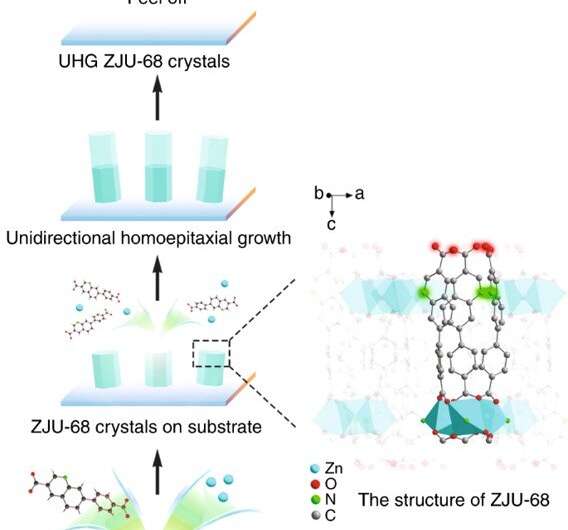
Multicolor single-mode polarized microlasers containing an output range from visible light to the near-infrared have significant applications in photonic integration and multimodal chemical sensing or imaging applications. However, such devices are very difficult to realize in practice. In a new report, Huajun He and a research team in physics, materials science and chemistry in Singapore, China and the U.S., developed a single crystal with multiple segments to generate controlled, single-mode, near-infrared (NIR) lasing. Multiple segments of the single crystal were based on a metal organic framework (MOF) hybridized with dye molecules suited for green, red and near-infrared lasing as computationally simulated. The segmented assembly of different dye molecules in the microcrystal caused it to act as a shortened resonator to achieve dynamic, multicolor single-mode lasing with a low three-color-lasing threshold (red, green and NIR). The findings will open a new route to explore single-mode, micro/nanolasers constructed with MOF engineering for biophotonic applications. The work is now published on Nature Light: Science & Applications.
Multicolor single-mode polarized laser sensing with metal organic frameworks (MOFs)
Multicolor single-mode polarized laser sensing or imaging is a promising diagnostic technology that remains to be effectively developed in practice. Different biological tissues, cells or biochemicals have different optical, thermal and acoustic responses to different wavelengths of light. As a result, light source with broadband multicolor output can provide the fundamental basis for multimodal or multidimensional sensing or imaging. The polarization properties of light provide an opportunity to process scattered signals for structural information rich in biological materials. Single-mode micro/nanolasers can meet requisite applications of miniaturized photonics devices; which include high information accuracy, avoiding false signals, and intercalating the interference of different optical signals to achieve target sensing or imaging of different cells and molecules.
Metal organic frameworks (MOFs) are a periodic crystalline material assembled by metal ions and organic bridging ligands to provide a powerful hybrid platform to overcome existing challenges of multicolor microlasers. The smooth and regular crystal structure of the MOF can efficiently act as an optical resonator to provide optical feedback. In this work, He et al. demonstrated the simultaneous assembly of different dye molecules based on the host framework ZJU-68 to achieve multicolor single-mode lasing.
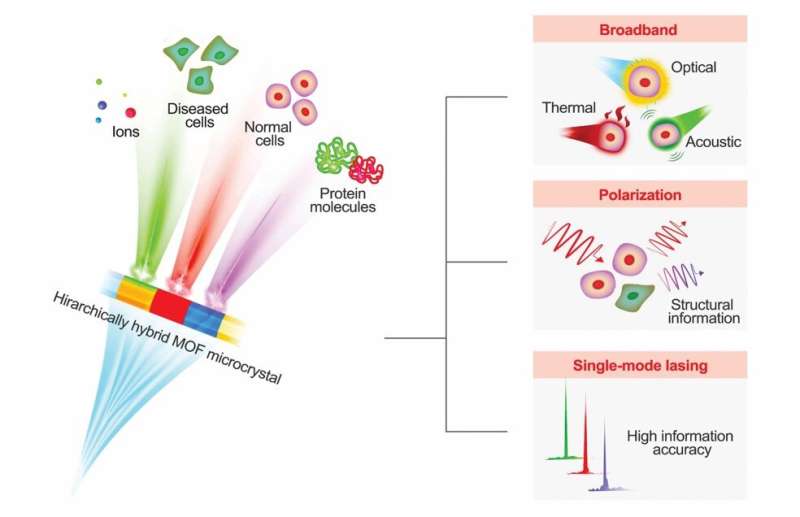
Synthesis and characterization of dye-assembled MOFs
The MOF microcrystal contained a variety of dye molecules, the scientists first used a computational simulation to reveal the lasing pattern of the material for possible lasing mode mechanisms. The results showed a new route for multicolor solid-state micro-laser materials for photonic integration and biochemical sensing or imaging. The team controlled the unidirectional growth of MOF crystals to assemble different guest materials/dye molecules on the structure and synthesized a dye-assembled hierarchical hybrid metal-organic framework. During synthesis, first, they self-assembled zinc ions (Zn2+), an organic linker, and a dye molecule to form dye 1. Then they immersed the resulting microcrystals into a new reaction solution of Zn2+ and an organic linker with a different dye molecule to form dye 2. For step three, they repeated the second step to obtain a three-color hierarchical hybrid microcrystal dye. The team combined the three different dye molecules abbreviated as DPBDM, DMASM and MMPVP to achieve different types of hybrid MOF single crystals. All hybrid single crystals maintained the same hexagonal prism structure to that of the pure form of host ZJU-68 framework except for the color changes that resulted from dye molecule assembly. The assembled dyes corresponded to light yellow, magenta and purple colors, respectively. The team conducted powder X-ray diffraction patterns of the dye assembled on the ZJU-68 hierarchical microcrystals, which were in good agreement with simulations.
Multicolor fluorescence and Multicolor lasing performance
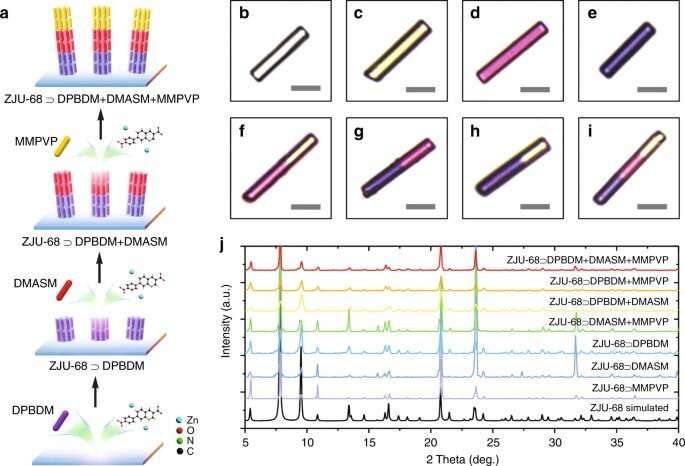
The team then compared the photoluminescence spectrum of dye-assembled ZJU-68 hybrid crystals. To achieve this, they used a mercury lamp with a 480 nm excitation filter set and determined the green, red and near-infrared emission peaks. Using multichannel confocal laser microscopy, He et al. showed how the hybrid single crystal with three dyes could be combined with incident light and filter modules for segmented excitation, and different color fluorescence signal output. The process prevented aggregation-caused quenching effects during dye assembly and assisted energy transfer from short-wavelength dye molecules to long-wavelength dye molecules for efficient multi-wavelength emission output.
The scientists further studied the lasing property of an individual small hybrid crystal containing the three dye molecules under a microscope. They used a 480 nm laser beam coupled into the microscope to collect a photoluminescence signal using a fibre-optic spectrometer. Based on the results, He et al. credited the three-color lasing process to whispering gallery mode (WGM) mechanism of the hexagonal prism crystal. To further understand lasing mode mechanisms in the hexagonal cavity, they conducted optical simulations using COMSOL Multiphysics software. They noted the internal reflection of the six crystal facets to be characteristic to the WGM mechanism of simulated diagrams.
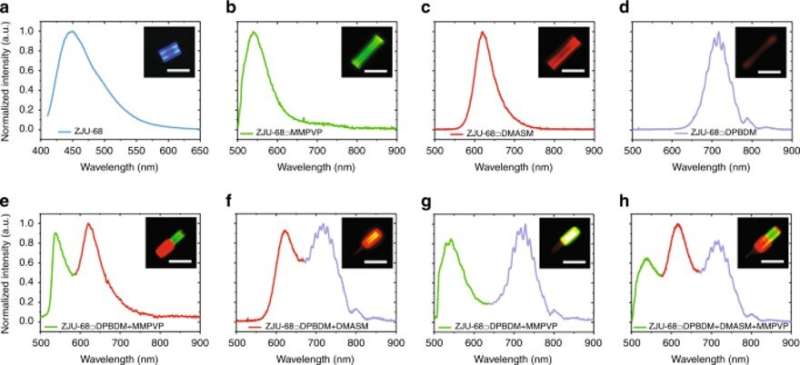
Scanning laser performance in a hybrid microcrystal
The team could simultaneously excite the material at the junction of two crystal segments to experimentally obtain bright green/red or red/NIR lasing. The unique setup allowed a laser of a specific color or a combination of colors to be controlled in a micro-nano-space for diverse biophotonic applications. Thus far the scientists achieved three-wavelength, single-mode lasing in the three-color hybrid crystal with significant lasing light polarization. By aligning the emission transitions of these dye molecules, He et al. obtained significant emission anisotropy (i.e. light emitted by the fluorophores had equal intensities). Such anisotropic multicolor lasing results have great potential for biochemical sensing or imaging and optical signal processing applications.
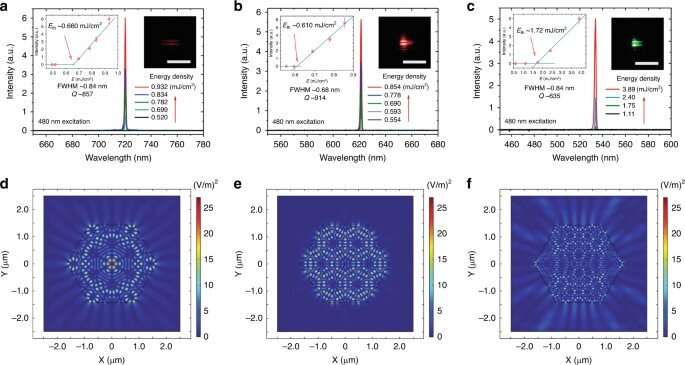
In this way, Huajun He and colleagues developed a hierarchical assembly of different dye molecules in a host-guest hybrid process on a metal organic framework (MOF) micro-resonator. Using the platform, they achieved up to three-wavelength single-mode lasing. The segmented assembly controlled the color output of the micro-laser and resolved adverse effects of energy transfer between different dye molecules. The three-color single-mode lasing process offered a wavelength range from visible to NIR in a monolithic structure. The work simplifies the process of developing a single-mode laser structure for multimodal biophotonic applications.
More information: Huajun He et al. Controllable broadband multicolour single-mode polarized laser in a dye-assembled homoepitaxial MOF microcrystal, Light: Science & Applications (2020). DOI: 10.1038/s41377-020-00376-7
H. Furukawa et al. The Chemistry and Applications of Metal-Organic Frameworks, Science (2013). DOI: 10.1126/science.1230444
Rajan S. Gurjar et al. Imaging human epithelial properties with polarized light-scattering spectroscopy, Nature Medicine (2002). DOI: 10.1038/nm1101-1245
Journal information: Light: Science & Applications , Nature , Science , Nature Medicine
Provided by Science X Network
© 2020 Science X Network




















